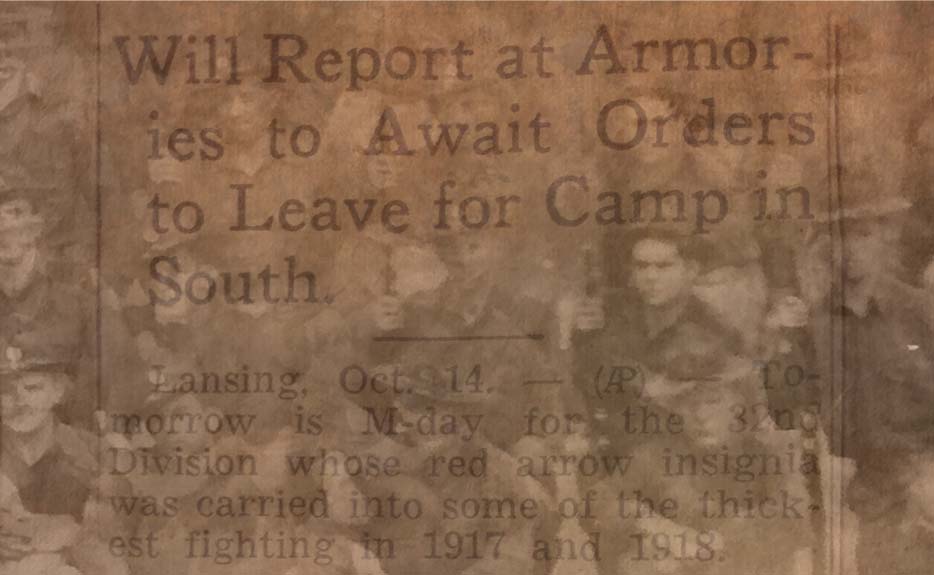
- Historical Date: October 14, 1940
- Location:Lansing, MI
Will Report at Armories to Await Orders to Leave for Camp in South
Lansing , Oct. 14 – Tomorrow is M-day for the 32nd Division whose red arrow insignia was carried into some of the thickest fighting in 1917 and 1918.
Tomorrow Michigan National Guardsmen whose units are included in the 32nd report at their armories to await further orders just as they did in August and September of 1917. Then they were sent to Camp MacArthur at Waco, Texas to assemble for training and drilling. This time they expect to go to Camp Beauregard, La. The date for assembly in the south has not yet been announced.
Col. Leroy Pearson, chief of staff and head of the Michigan component of division headquarters here, said today it was “expected that orders will be received soon after the 15th for the assembly of the division and its movement south.”
A mobilized guardsman’s first duty tomorrow morning will be to submit to a physical examination by a board of medical officers.
Col. Pearson said that while at their home stations the guardsmen will undergo normal duties of training and will prepare equipment and records for shipment.
Some guardsmen will remain on duty at the various armories tomorrow night, Col. Pearson said, while others will return to their homes for the night. Such arrangements will depend upon the facilities available and the other of the unit’s commanding officer.
The 32nd now, as in 1917, is made up of Michigan and Wisconsin guardsmen. It is under the command of Major General L. A. Fish, of Milwaukee, who succeeded the late Major General Guy M. Wilson, of Flint, in an alternation of command between the two states.
The Michigan component of the division includes the 63rd Infantry brigade under Brigadier General Thomas Colladay, of Flint. In the 73rd are the 125th Infantry regiment, commanded by Col. Atthias A. Wiesenhoefer, of Detroit, and the 126th Infantry regiment, under Col. William Haze, Grand Rapids. Saginaw, Owosso, Ann Arbor, Flint, Port Huron, Monroe, Pontiac and Detroit guardsmen are in the 125th while the 126th is made up of Muskegon, Grand Rapids, Grand Haven and other Western Michigan troops.
Besides the 63rd brigade, the division includes also several units of special troops under Lieut. Col. John J. Ostrander, of Detroit. These are the headquarters detachment of Lansing; the 32nd signal company of Ypsilanti, and the 107th ordnance of Pontiac.1
In 1940, WWII was raging in Europe. That fall, the nation’s first peacetime draft was enacted and the National Guard was called to active duty.2
This article was dated October 14. The year, while not listed, was 1940. This is listed as my grandfather’s enlistment date on his military records. At one time he had said he signed up to avoid the draft. I’m no expert on what is registered as an enlistment date – it could be the day he signed up, or the date they were called to active duty. It seems to me he was in the guard before getting sent away for training, so this could be the date they were mobilized. Whichever it was, this was certainly the day they began the journey that would eventually bring them to the faraway jungles of Papua New Guinea.
- Muskegon Chronicle, Oct. 14, 1940
- Powers, Rod. “History of the Army National Guard.” The Balance, Oct. 15ADAD, 2016, www.thebalance.com/history-of-the-army-national-guard-3353242.

0 comments